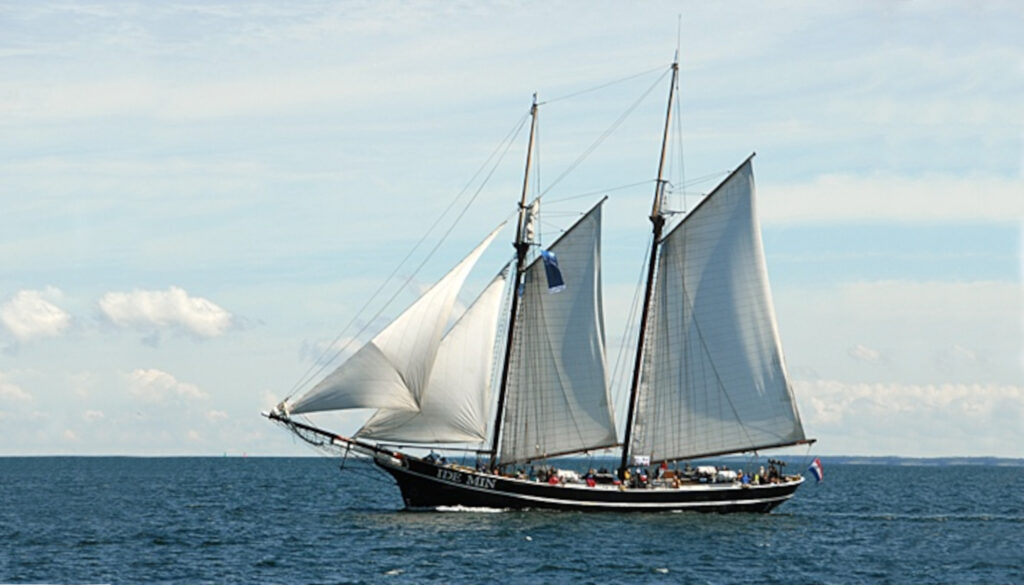Sailing for cocoa, coffee beans and rum
Writer Alma Mathijsen crosses the Atlantic on a sailing freighter to pick up coffee beans, cocoa and rum in South America. Climate-wise, however, the venture may be achieving the opposite of what she thought.
In a small side port of Amsterdam lies a sailing ship that wants to compete with the immensely polluting container transport at sea. Every year, the entire shipping industry emits 1 billion tonnes of CO2, about the same as aviation; each about 3 per cent of total CO2 emissions.
Yet sea freight is often left out of the picture when it comes to the climate crisis; it happens far away from us, we do not directly breathe in the emissions from the heavy fuel oil that ship engines use.
But there are those who oppose regular cargo transport by sea. All over the world, then, cargo sailing ships are popping up to show that shipping can be done differently. One who is trying is Dutchman Huib Koel, a burly man with a big heart. He converted a 1957 tug into a sailing boat: the Ide Min. With other do-gooders, he wants to cross the Atlantic to pick up coffee beans, cocoa and rum on the other side. Products that cannot be grown in the Netherlands. At the beginning of winter, the Ide Min would leave for the first time. The trip would go from the NDSM wharf in Amsterdam North to Suriname, Guadeloupe, the Dominican Republic and Colombia. They expected to return sometime in April.
I heard about this special plan, and immediately asked if I could come along. Ten years ago, I had made the crossing by sailboat and never before had I seen so much beauty in 17 days. But the North Atlantic is unprecedentedly warm and is rapidly acidifying due to absorption of CO2 from the atmosphere, KNMI paints an alarming picture in a series of climate reports. I wanted to visit the feverish sea to see for myself how it is doing. My new book was almost finished, the last bit I could also do aboard ship. The crossing would take three weeks. That fitted exactly. And I was looking forward to following a group of people who, like me, love the sea.
[…]
Day 18
We see a giant container ship on the horizon, at least 400 metres long. It looks like a square land, moving steadily past us, unaffected by the swell.
‘If Ide Min’s cargo were put into such a container ship, it would produce fewer emissions than we are producing now.’ I look wide-eyed at Lucy.
‘Yes,’ she continues, ‘because those ships are so gigantic. For a ship that size, what we carry is a minuscule addition. The biggest cargo ships carry about 22 thousand containers at a time, in the belly of the Ide Min only fits the contents of two and a half containers.’
‘Then what on earth are we doing here?”, I ask. ‘People’s mentality has to change. That is the only solution. We have to want less.’
By making ships bigger and bigger, the amount of emissions per product shrinks, but overall pollution actually increases. ‘I feel fooled. We are at the mercy of sea freight and failure to regulate it by governments around the world. Individual resistance hardly makes sense.
Day 21
Today we have been on board for exactly three weeks. I had thought we could almost see Suriname by now. ‘This is the climate crisis,’ says Huib, ‘we are in the middle of it.’
‘The trade winds are dead,’ says the captain who by now has also become grumpy about the lack of wind. ‘Then how do we get on?’, I ask as I try my best to hide my panic. ‘It’s like the Alps: there is still some snow, but you have to look harder.’
[…]
Day 41
A narrow line winds on the horizon. Nobody yells, nobody screams, but inside me it churns with excitement. I slide behind my laptop to book a ticket home. It is over. I no longer have to wonder when this will end.
A fishing boat appears in the distance. It is coming to pick us up in the middle of the sea, because we have no engine to take us up the Suriname River. But the fishing boat is not made for open water. She sways back and forth on the waves, almost throwing off the heroes who have come to rescue us. And then we drift onto a sandbank. We get stuck, reports the captain nervously. Suddenly, everything moves fast. Where time was slow as quicksand in the past few weeks, we are now entering a whirlwind. Everyone helps, I do my utmost not to paralyse with fear. I fail. I stand fixed and watch. The boat bumps against us, lines are thrown out and knots are tied faster than ever. A roaring engine drowns out the silence that clung to us for so long. I see the crew lowering the sails. They are no longer needed. In a few hours, we can set foot ashore.
[…]
The Ide Min takes twice as long as expected, and Alma proves ill-equipped to cope. Her account is therefore a personal one, with ups and downs (ed.).
Read the much fuller article in the Volkskrant (subscribers only).


